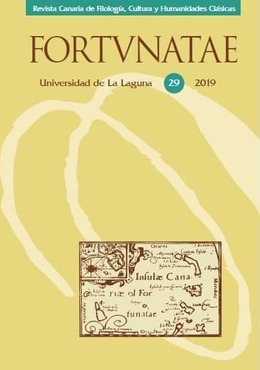Agamémnon e Clitemnestra na escola: Os clássicos como tema estruturante de The Browning Version
Resumen
Este texto analisa a forma como o dramaturgo inglês Terence Rattigan recorre à tragédia Agamémnon de Ésquilo para dar corpo ao texto dramático de sua autoria,The Browning Version (1946). A análise que se propõe contempla ainda a forma como os elementos da cultura grega foram incluídos e adaptados nas versões cinematográficas que Anthony Asquith e Mike Figgis fizeram da peça de Rattigan em 1951 e 1994, respectivamente.
Citas
AGUILAR MIQUEL, J. (2015): «La traducción pedagógica como herramienta didáctica: hacia una nueva propuesta de aplicación en el aula», Thamyris 6: 137-165.
BENARDETE, S. (1997): The Bow and the Lyre. A Platonic Reading of the Odyssey, Rowman & Littlefield Publishers, Lanham.
BERTOLINI, J. A. (2016): «The Browning Version: Words could so lacerate a man’s heart», in The Case for Terence Rattigan, Playwright, Palgrave MacMillan, Middlebury, pp. 101-112.
COELHO, M. C. M. N. (2009): «A recepção de Agamêmnon nas terras da Rainha. As versões de Browning, Rattigan, Asquith e Figgis», Aletria 19 (n.e.): 163-176.
FERREIRA, F. (2017): «Ensinar e aprender Latim no século XXI», BEC 62: 125-137.
FOX,R.L.(2010):«Alexander on Stage:ACritical Appraisalof Rattigan’sAdventure Story», inP.CARTLEDGE & F. R. GREENLAND (eds.), Responses to Oliver Stone’s Alexander. Film, History, and Social Studies, The University of Wisconsin Press, Madison, pp. 55-91.
LOURENÇO, F. (2018): Homero. Odisseia, Quetzal Editores, Lisboa.
MARTÍNEZ HERNÁNDEZ, M. (2012): «La literatura griega antigua en el cine», in G. SANTANA HENRÍQUEZ (ed.), Literatura y Cine, Ediciones Clásicas, Madrid, pp. 11-65.
PALAIMA, T. G. (2002): «The Browning Version’s and Classical Greek. “TAPLOW. It’s for you, Sir”», in B. AMDEN et al., Noctes Atticae. 34 Articles on Graeco-Roman Antiquity and its Nachleben. Studies presented to Jørgen Mejer on his Sixtieth Birthday March 18, 2002, Museum Tusculanum Press, University of Copenhagen, Copenhagen, pp. 199-214.
PATTERSON, R. G. (2009): Two Movies. Where they came from, How they work and What they mean, RGP, Los Angeles.
PULQUÉRIO, M. O. (1992): Ésquilo. Oresteia – Agamémnon, Coéforas, Euménides, Edições 70, Lisboa.
RATTIGAN, T. (1955): The Deep Blue Sea, with three other plays: Harlequinade. Adventure story (and) The Browning version, Pan Books, London.
RATTIGAN, T. (1994): The Browning Version, Nick Hern Books, London.
ROCHA PEREIRA, M. H. (1996): Eurípides. As Troianas, Edições 70, Lisboa.
RODRIGUES, N. S. (2001): «Garrett e a tragédia de tema clássico. O exemplo de Mérope», Humanitas 53: 385-408.
RODRIGUES, N. S. (2010): «Ainda Clitemnestra, a “mulher de máscula vontade”», Cadmo 20: 393-405.
SOLOMON, J. (2001): The Ancient World in the Cinema, Yale University Press, New Haven.
SOUSA, A. A. A. (1994): «Do Latim ao Português: breve abordagem da problemática da tradução», Clássica 20: 343-349.
SOUSA E SILVA, M. F. (2005): Ésquilo, o Primeiro Dramaturgo Europeu, Imprensa da Universidade de Coimbra, Coimbra.
Los autores conservan los derechos de autor y garantizan a la revista el derecho de ser la primera publicación del trabajo al igual que licenciarlo bajo una Creative Commons Attribution License que permite a otros compartir el trabajo con un reconocimiento de la autoría del trabajo y la publicación inicial en esta revista.
Los autores pueden establecer por separado acuerdos adicionales para la distribución no exclusiva de la versión de la obra publicada en la revista (por ejemplo, situarlo en un repositorio institucional o publicarlo en un libro), con un reconocimiento de su publicación inicial en esta revista.





